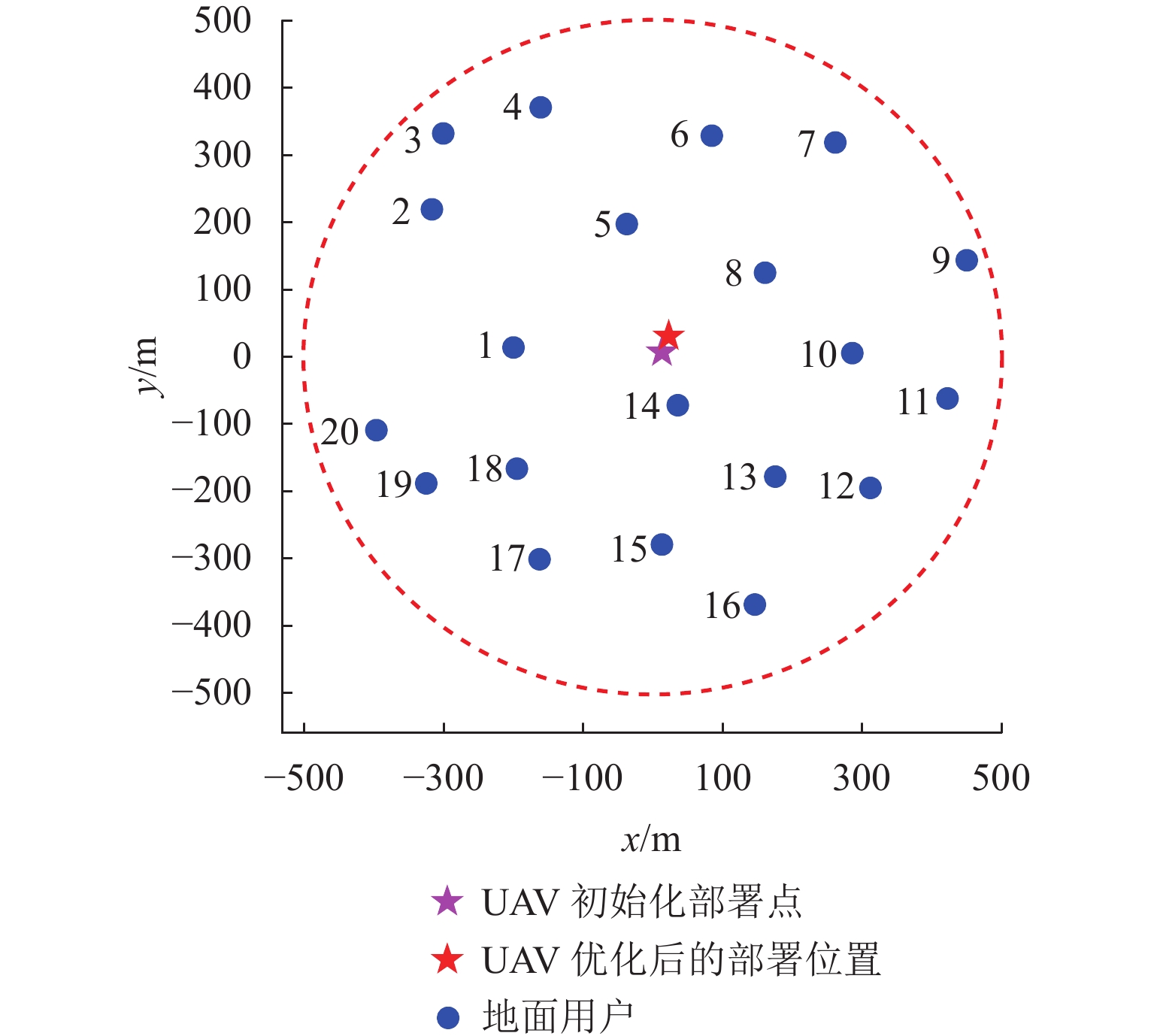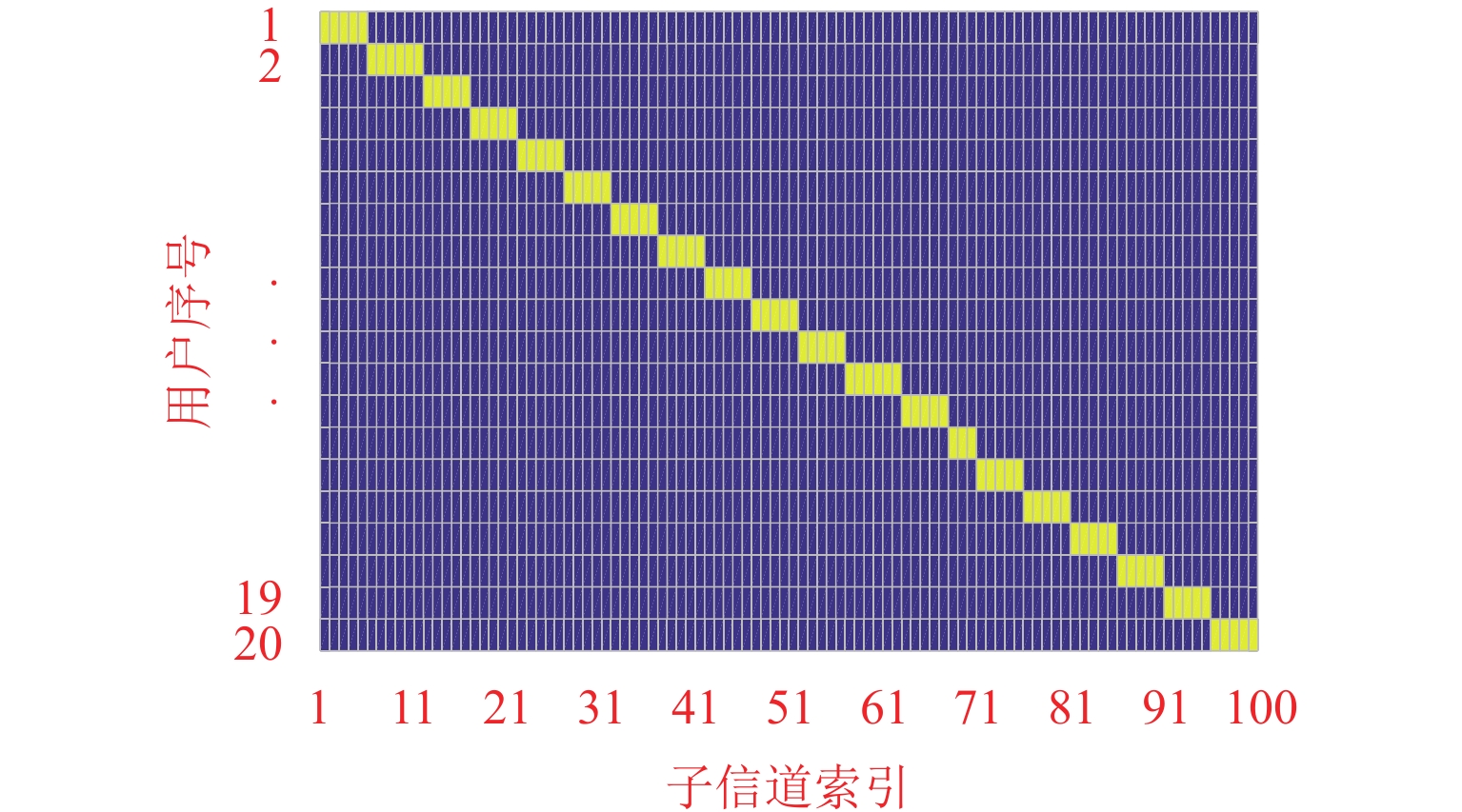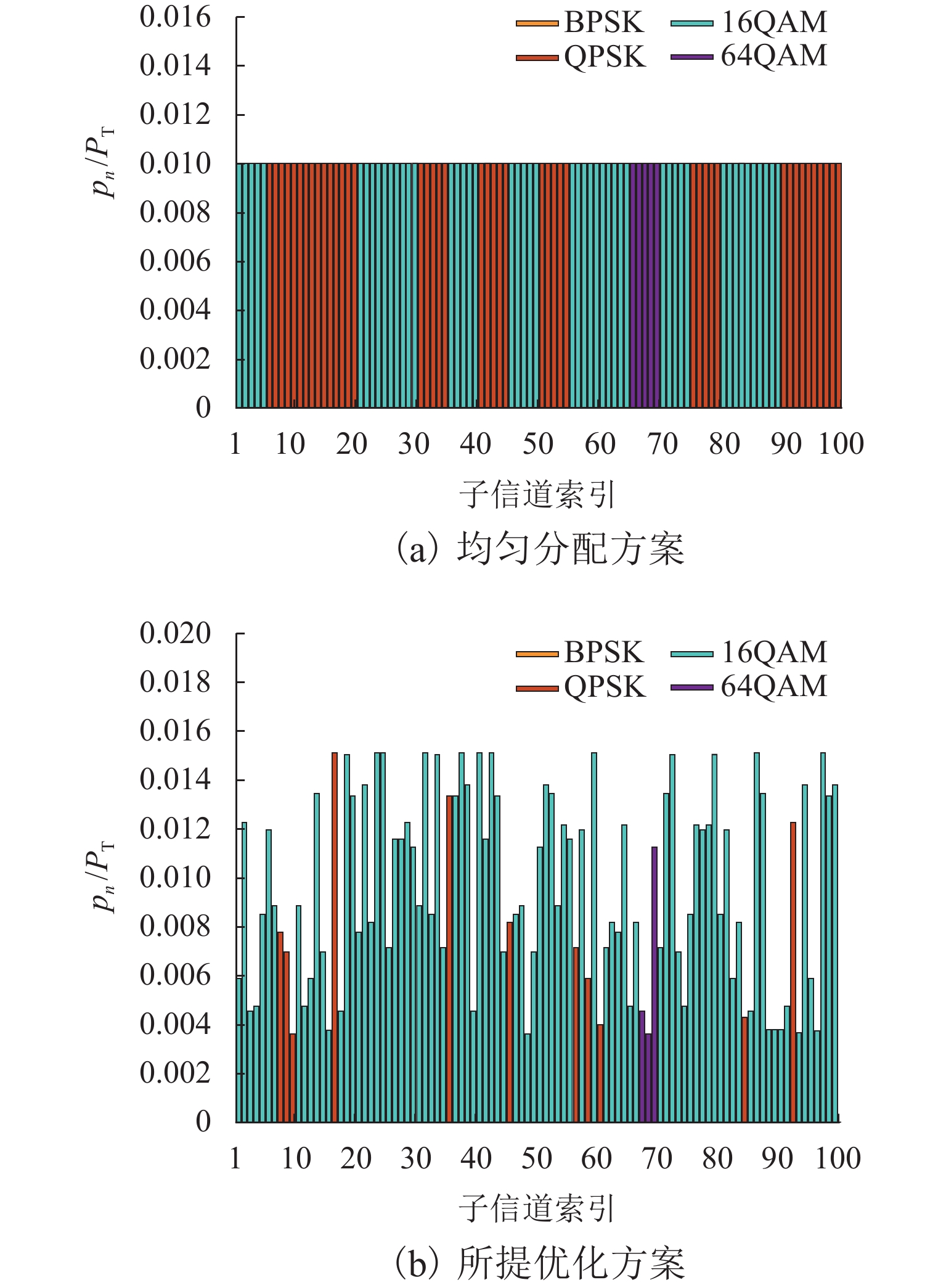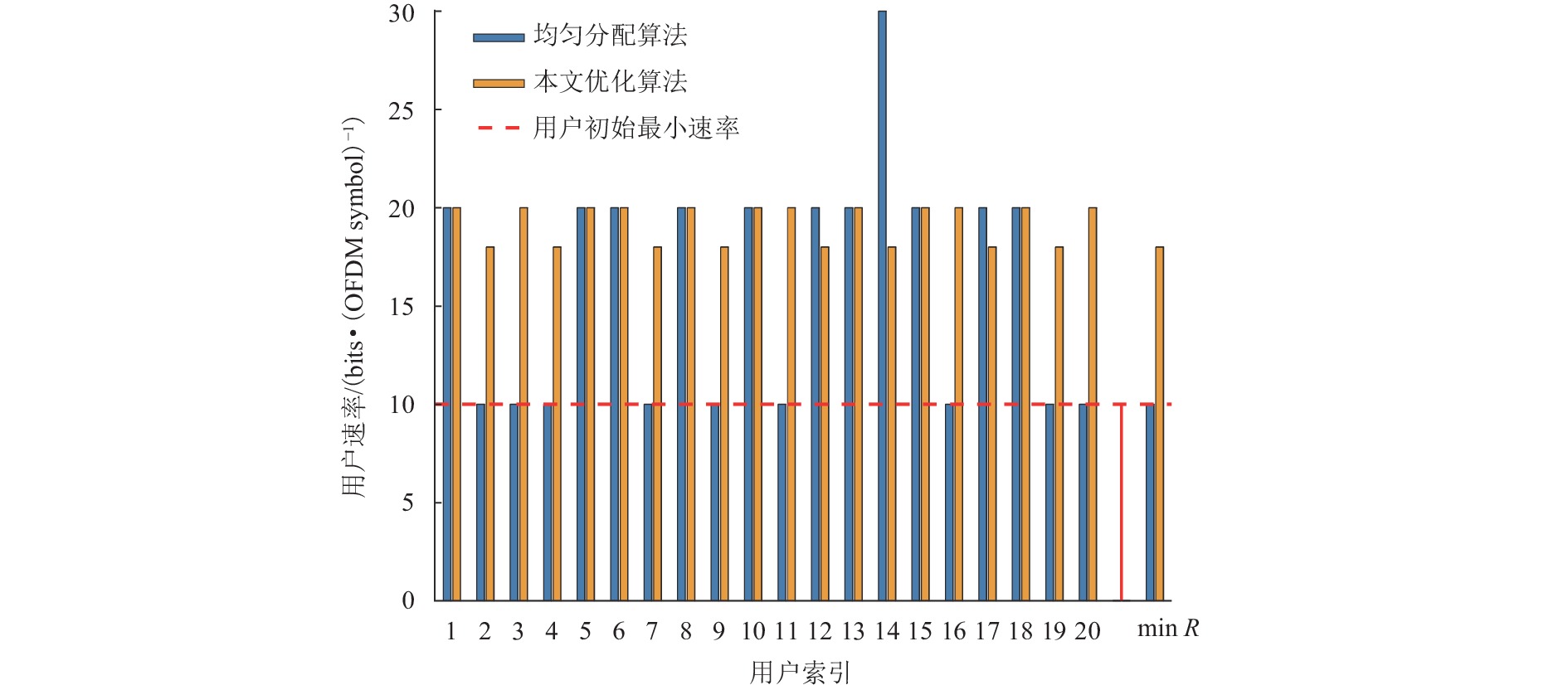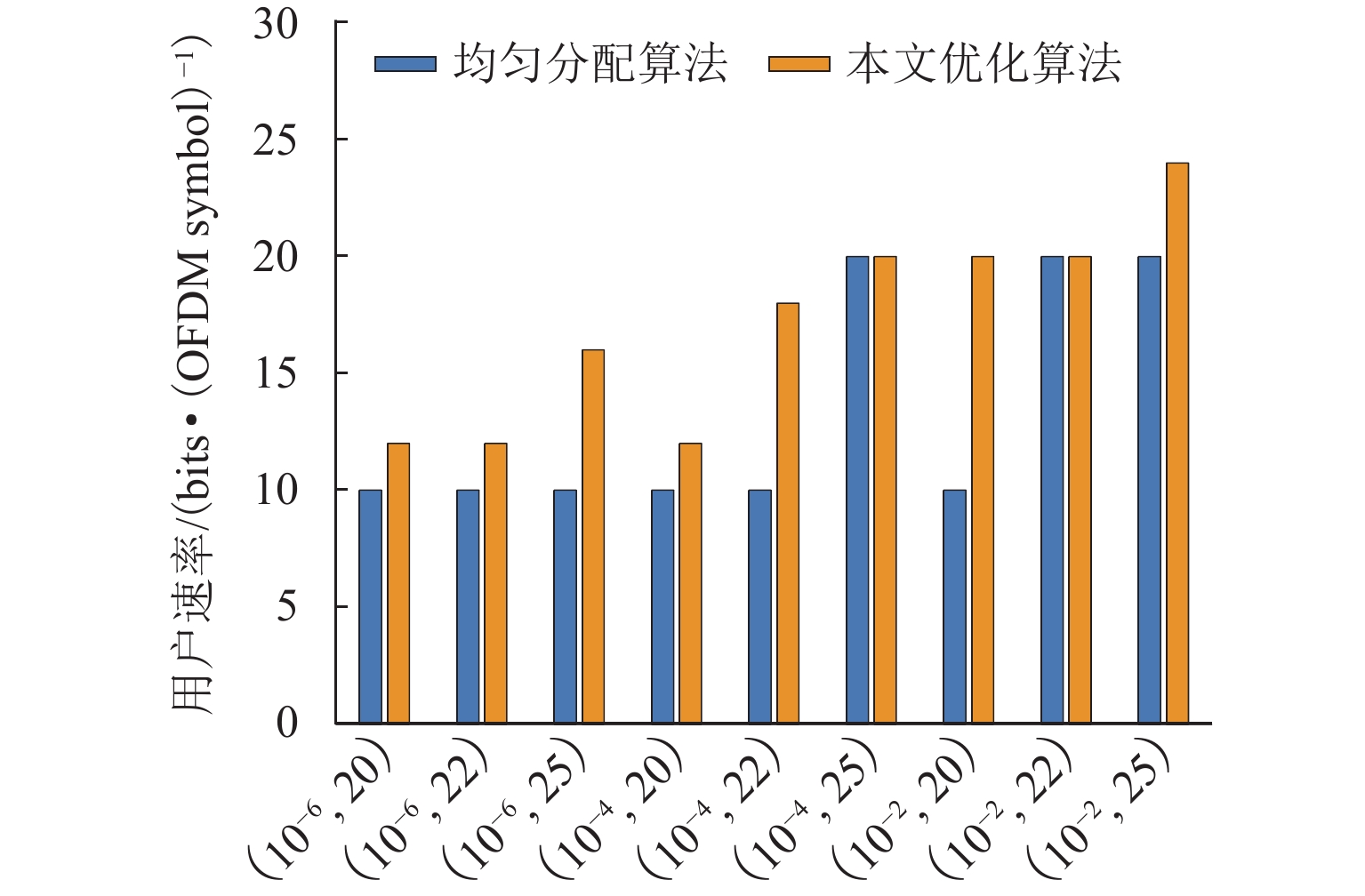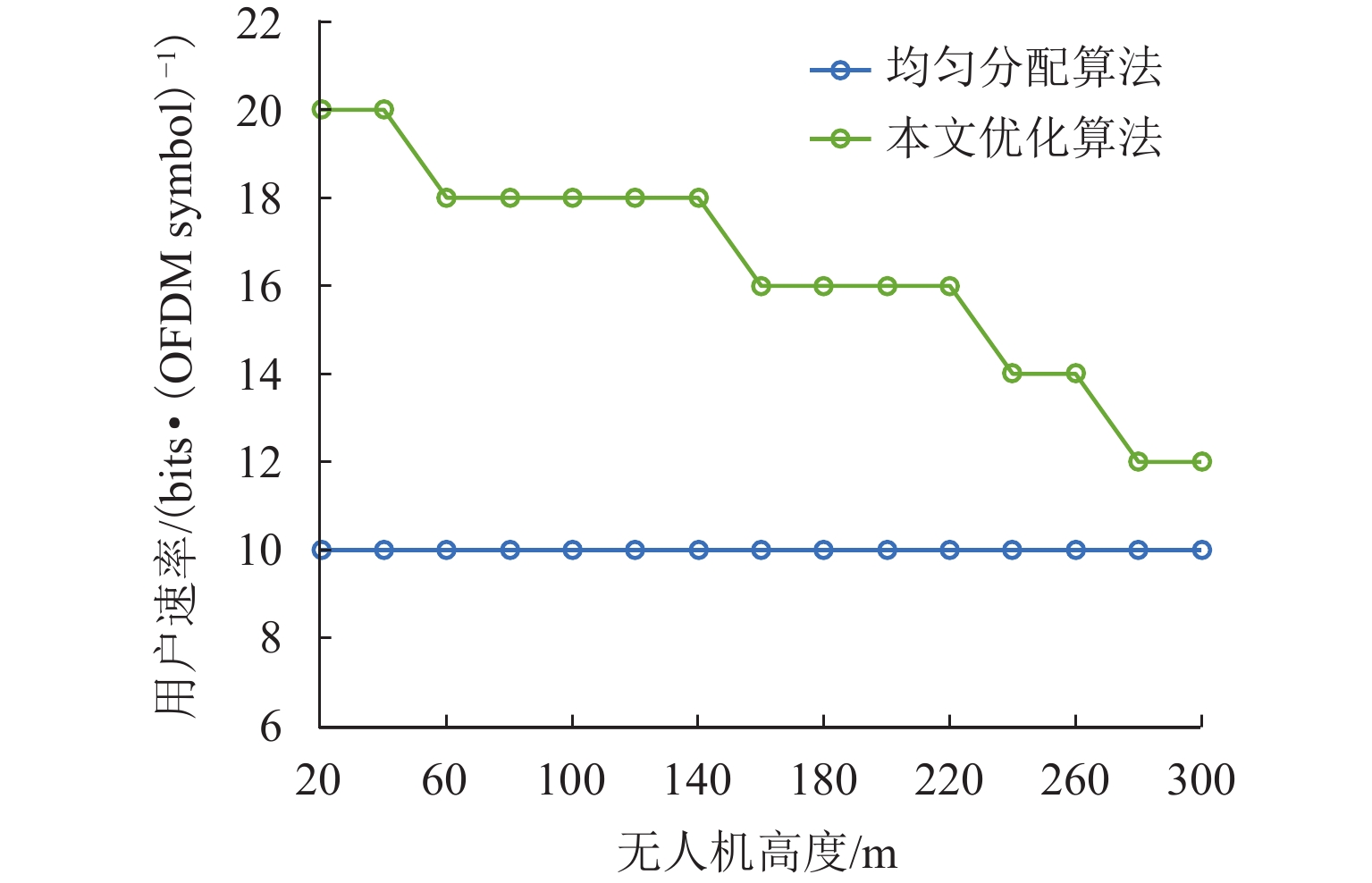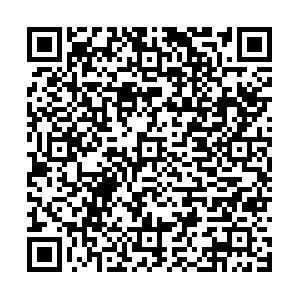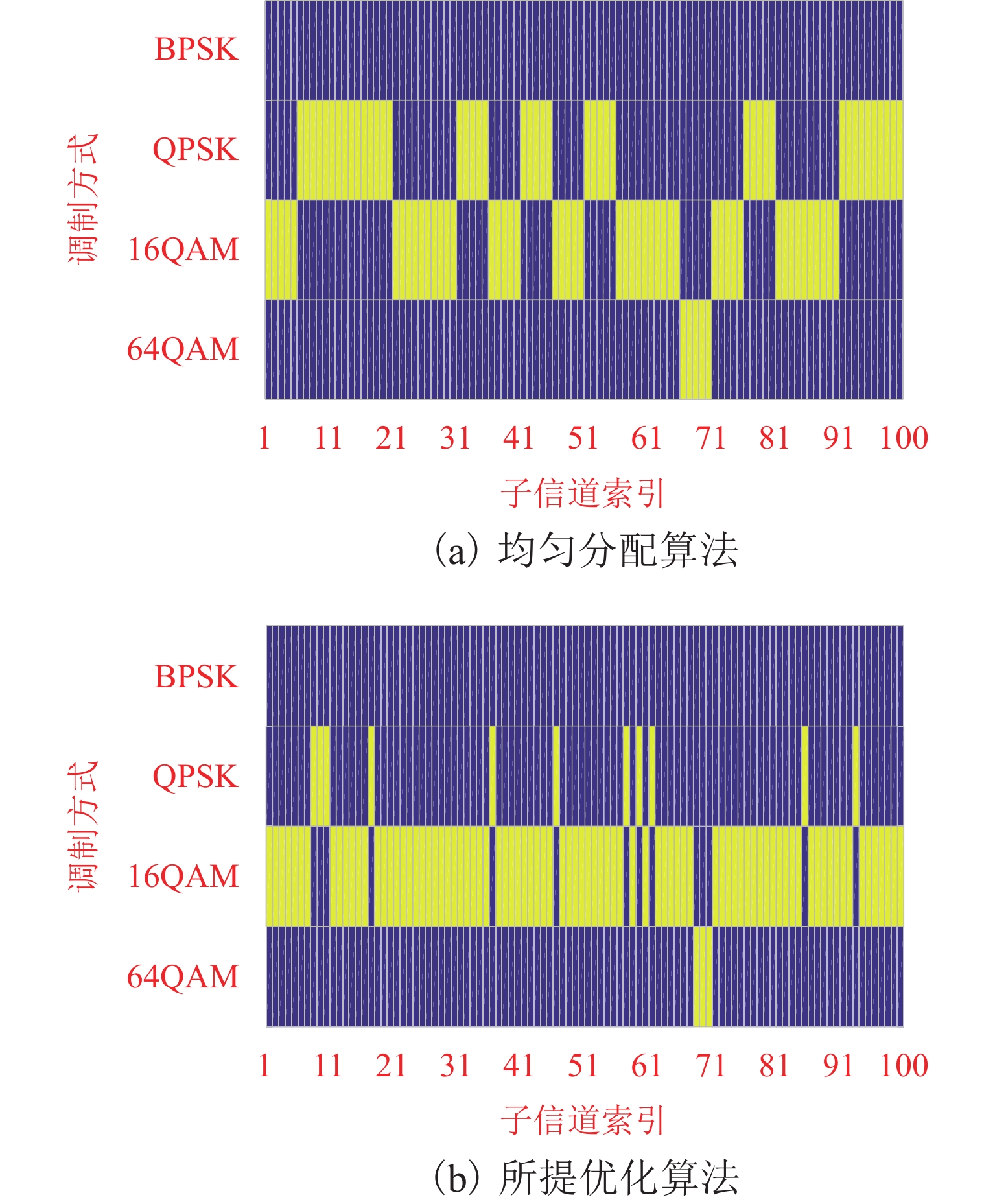Joint Optimization of Resource Allocation and Deployment Location in Unmanned Aerial Vehicle-Assisted Communication
-
摘要:
为提升基于正交频分多址接入模式无人机辅助无线通信系统的网络性能,首先,以提升用户的公平性为系统方案设计指标,将包括子信道分配、调制模式选择、功率分配等通信资源和无人机位置联合建模为一个混合整数非线性优化问题;进一步,利用迭代优化的方式解决变量耦合性及非凸性等问题,将最大-最小问题转换为两个子问题:子信道分配和调制方式选择联合优化、无人机位置和子信道功率联合优化;然后,通过适当变换将子信道分配和调制方式选择联合优化建模为0-1线性优化问题进行求解,而无人机位置和子信道功率联合优化建模为凸优化问题求解;最后,进行实验仿真验证. 研究结果表明,所提联合优化算法相比基本方案可有效提升网络用户的公平性.
Abstract:To enhance the performance of the unmanned aerial vehicle (UAV)-assisted communication network based on the orthogonal frequency division multiple access (OFDMA) mode, the rational network allocation and optimal allocation of communication resources were studied. Firstly, in order to maximize the fairness of the network, a mixed-integer nonlinear maximum-minimum optimization problem was modeled by combining the communication resources including sub-channel allocation, modulation mode selection, and power allocation with UAV position. Then, the iterative optimization method was used to solve the problems of variable coupling and non-convex, and the maximum-minimum problem was converted into two sub-problems: joint optimization of sub-channel allocation and modulation mode selection and joint optimization of UAV position and sub-channel power. Finally, by means of appropriate transformations, the two subproblems were modeled into 0–1 linear optimization problem and convex optimization problem for solution. The experimental simulation results show that the proposed algorithm can jointly optimize multidimensional system parameters such as network allocation and communication resources, effectively enhance the fairness of network users, and improve network performance compared with other benchmark schemes.
-
近几十年来,借助于信息技术的快速迭代和制造工艺的飞速发展,无人机在军事、运输、农业等领域广泛应用[1-3]. 无人机具有价格低廉、部署方便、移动灵活、控制简单等优势,将其融入移动通信系统已成为提升通信服务质量的重要举措,得到了学界和工业部门的广泛关注[4-6]. 无人机既可作为移动用户,利用现有的地面基础通信网络对其提供指令、传输数据等业务,提高无人机通信的可靠性和有效性;同时,无人机也可充当空中基站或中继节点,为特定地区或时段提供不间断、宽覆盖的通信服务,并利用良好的空域传输条件满足高速率、低延迟的通信需求. 无人机通信作为现有通信系统的重要补充,克服了地面基础设施的诸多限制,在提高网络覆盖率、改善网络服务质量、增进系统可靠性等方面具有重要意义. 然而,无人机通信也面临诸多挑战. 一方面,受尺寸、载荷、功率等限制,无人机通信的频谱和发射功率有限,需要有效分配通信资源;另一方面,无人机的灵活性和移动性对节点部署提出了高要求,需要合理设计轨迹或位置,以提升网络性能[7-9].
无人机通信系统的资源分配和轨迹/位置优化问题备受关注. 文献[10]研究了多无人机作为移动基站的通信系统中用户分配和无人机轨迹联合优化方法;文献[11]针对不同的用户需求,以提升用户公平性为目标,研究无人机通信系统中的带宽、功率和轨迹联合优化问题;文献[12]利用博弈论研究任务驱动下的无人机通信系统频谱分配;文献[13-14]探讨了无人机作为中继节点的网络资源分配和轨迹优化等问题. 正交频分多址接入(orthogonal frequency division multiple access, OFDMA)作为高效的多载波通信技术,已成为多个商用系统的标准多用户接入方式[15-16]. 文献[17]以无人机作为空中基站工作在OFDMA模式下,研究无人机轨迹和网络资源联合优化方法,提升网络公平性; 文献[18]研究无人机辅助蜂窝通信系统中的资源分配和轨迹联合优化问题,提出迭代优化算法实现网络容量的最大化;文献[19]基于智能超表面(intelligent reflecting surface, IRS)辅助的OFDMA无人机通信系统,研究无人机轨迹、网络资源、IRS配置的联合优化问题. 上述文献均是基于理论容量进行优化分析,实际应用中,主流的无人机系统和无线通信系统均为数字通信方式,数据速率和可靠性是系统设计的重要依据. 文献[20]将一定数据速率和误码率作为OFDMA无人机网络的限制条件,以最小化传输功率为目标,研究子载波分配、调制模式选择和轨迹联合优化问题,但尚未考虑功率分配等因素,也未进一步考虑提升网络速率、公平性等指标.
基于上述问题,本文以最大化用户最小传输速率为目标,在一定的误码率要求下,考虑网络资源分配和无人机位置联合优化问题. 所建问题为混合整数优化问题,直接求解难度较大. 为解决变量间的耦合性,将联合优化问题分解为2个子优化问题,并通过适当变换转化为0-1线性优化和凸优化问题,利用迭代优化方法进行求解. 最后,通过实验仿真和算法对比验证所提算法的有效性和公平性.
1. 系统模型
考虑将无人机作为空中基站的场景,系统模型如图1所示. 在通信服务区域内,存在一个空中悬停无人机作为空中基站,同时为M个地面用户提供通信服务. 为描述方便,设定用户索引集合为M={1,2,⋯,m,⋯,M}. 特别地,为提升频谱效率,设定无人机基站工作在OFDMA工作模式,系统总带宽为B,均分为N个子载波,单个子载波带宽Δf=B/N,子信道索引集合为N={1,2,⋯,n⋯,N}. 基站会根据用户的需求及信道质量分配一定数量的子信道,且同一子信道仅能分配到至多1个用户. 因此,不同用户之间不存在信道间干扰. 定义子信道分配变量αmn,若子信道n分配给用户m,αmn=1,反之,αmn=0. 另外,为提升系统性能,基站可根据一定的算法自适应调整各子信道的功率分配和调制方式. 不失一般性,本文考虑正交幅度调制(quadrature amplitude modulation,QAM),选定的调制维度集为cn∈{1,2,4,6},即系统可自适应选择BPSK、QPSK、16QAM和64QAM 4种调制方式. 在实际应用中,可根据具体情况选定合适的维度集或其他调制方式.
设定无人机悬停高度为H,其平面坐标q=(xU,yU). 类似地,假定地面用户的垂直高度为0,相应地,用户m的平面坐标wm=(xm,ym).
相比于地面通信系统,无人机通信具有良好的视距到达特性,无人机—地面信道极少会受到障碍物及非视距分量的影响,信道传播质量主要取决于直达链路. 类似于文献[21-22],本文选择直达链路为信道传播模型. 基于自由空间信道传播模型,UAV与用户m之间的信号功率衰减系数为[21-24]
hm=β0H2+‖q−wm‖2, (1) 式中:β0为单位距离(1 m)处的信号功率衰减量.
假定各子信道独立选择QAM调制方式,用户m的接收信号误码率为Pem,若αmn=1,根据文献[25],用户m利用子信道n实现可靠接收信息符号所需的信噪比为
fm(cn)={12[Q−1(Pem)]2,cn=1,13[Q−1(Pem4)]2(2cn−1),cn=2,4,6, (2) 式中:Q−1(x)为式(3)所示Q函数的逆函数.
Q(x)=1√2π∫∞xe−t22dt. (3) 进一步地,UAV利用信道n服务于用户m所需的功率下界可表示为
pmnlim (4) 式中: \delta _0^2 为用户 m 处的噪声功率谱密度.
2. 问题建模
网络公平性是衡量通信系统性能的重要指标,能够确保稳定可靠的通信服务. 本文将提升网络的公平性作为系统设计的主要指标. 为得到优化的系统设计方案,首先需要对问题进行建模:将最大化用户最小信息速率作为优化目标,以有限的发射功率、子信道、调制方式作为限制条件,实现对子信道分配、功率分配、调制方式选择及无人机位置的联合优化. 为表示方便,优化变量可表示为: {{A}} = \{ {\alpha _{mn}}, \forall m \in \mathcal{M},\forall n \in \mathcal{N} \} , {{C}} = \left\{ {{c_n},\forall n \in \mathcal{N}} \right\} , {{P}} = \left\{ {{p_n},\forall n \in \mathcal{N}} \right\} 和 {q} = \left( {{x_{\mathrm{U}}},{y_{\mathrm{U}}}} \right) ,pn为第n个子信道功率. 相应地,联合优化问题可建模为
\begin{split} &\text{P0}:\underset{\left\{A,C,P,q\right\}}{\text{max}}\text{min}\;{R}_{m},\\ & \text{ s}\text{.t}\text{. }\quad {\displaystyle \sum _{n=1}^{N}{\alpha }_{mn}{c}_{n}}={R}_{m},\quad\forall m\in \mathcal{M},\\ &\qquad\quad {\displaystyle \sum _{m=1}^{M}{\alpha }_{mn}}\leqslant 1,\quad\forall n\in \mathcal{N},\\ &\qquad\quad {P} _{m}^{{\mathrm{\;e}}}\leqslant {P} _{\mathrm{max}}^{{\mathrm{\;e}}},\quad\forall m\in \mathcal{M},\\ &\qquad\quad {\displaystyle \sum _{n=1}^{N}{p}_{n}}\leqslant {P}_{{\mathrm{T}}},\\ &\qquad\quad {\alpha }_{mn}\in \left\{0,1\right\},\quad\forall m\in \mathcal{M},\;\forall n\in \mathcal{N},\\ &\qquad\quad {c}_{n}\in \left\{1,2,4,6\right\},\quad\forall n\in \mathcal{N}, \end{split} 式中: {R_m} 为用户 m 获取的信息速率, P _{\max }^{\mathrm{\;e}} 为误码率上限, {P_{\mathrm{T}}} 为UAV总发射功率限制.
明显地,所建立的优化问题P0为一个混合整数非线性优化问题,并且 {\alpha _{mn}} 和 {c_n} 、 {c_n} 和 {q} 之间互相耦合. 因此,很难直接求解该问题.
3. 问题求解
为解决优化问题P0中的变量耦合问题,采用迭代优化的方法进行求解. 利用梯度下降法将优化问题分解为2个子问题:子信道分配及调制模式识别优化问题、功率分配和无人机位置优化问题. 然后,利用迭代优化求解,得到优化的系统设计方案.
3.1 子优化问题1:子信道分配及调制模式选择优化
子信道分配系数 {\alpha _{mn}} 和调制模式选择系数 {c_n} 之间互耦,直接联合优化两类参数难度很大. 由于 {c_n} 取值为有限的4个离散值,因此,可将表达式 {\alpha _{mn}}{f_m}\left( {{c_n}} \right) 变换为式(5).
{q_m}\left( {b_{mn}} \right) = {\rho _{m1}}b_{mn} + 3{\rho _{m2}}b_{mn}^2 + 15{\rho _{m2}}b_{mn}^3 + 63{\rho _{m2}}b_{mn}^4, (5) {\rho _{m1}} = \frac{1}{2}{\left[ {{Q^{ - 1}}\left( {P_m^{\mathrm{e}}} \right)} \right]^2}, (6) {\rho _{m2}} = \frac{1}{3}{\left[ {{Q^{ - 1}}\left( {\frac{{P_m^{\mathrm{e}}}}{4}} \right)} \right]^2}, (7) 0 \leqslant \sum\limits_{s = 1}^4 {b_{mn}^s} \leqslant 1, (8) 式中:\rho _{m1}和\rho _{m2}为系数; b_{mn} \in \left\{ {0,1} \right\} ,为二进制变量,且应满足式(8)所示约束条件.
通过上述变换,可将优化变量 {\alpha _{mn}} 和 {c_n} 由 b_{mn}^s 替代表示,因此,子信道分配及调制模式选择优化问题可表示为
\begin{split} &\text{P1}:\;\underset{\left\{A,C\right\}}{\text{max }}\text{min }{R}_{m},\\ & \text{s}\text{.t}\text{.}\quad {\displaystyle \sum _{n=1}^{N}{r}_{mn}}={R}_{m},\quad\forall m\in \mathcal{M},\\ &\qquad {r}_{mn} = {b}_{mn} + 2{b}_{mn}^{2} + 4{b}_{mn}^{3} + 6{b}_{mn}^{4},\;\;\\ &\qquad\quad \forall m\in \mathcal{M},\;\forall n\in \mathcal{N},\\ &\qquad 0\leqslant {\displaystyle \sum _{s=1}^{4}{b}_{mn}^{s}}\leqslant 1,\quad\forall m\in \mathcal{M},\; \forall n\in \mathcal{N},\\ &\qquad 0\leqslant {\displaystyle \sum _{m=1}^{M}{\displaystyle \sum _{s=1}^{4}{b}_{mn}^{s}}}\leqslant 1,\quad\forall n\in \mathcal{N},\\ &\qquad{p}_{mn}\geqslant \dfrac{{q}_{m}\left({b}_{mn}^{s}\right){\delta }_{0}^{2}\Delta f}{{h}_{m}},\quad\forall m\in \mathcal{M},\;\forall n\in \mathcal{N}. \end{split} 优化问题P1为一个0-1整数线性规划问题,可通过成熟的算法(CPLEX或者MOSEK等)予以求解.
3.2 子优化问题2:功率分配及无人机位置联合优化
从信息速率的形式上看,在满足功率、误码率等约束条件下,用户的信息速率由子信道选择系数和调制模式选择系数决定. 因此,子问题1决定了用户的信息速率,在分配方案不变、满足相应约束条件情况下,用户信息速率不会随着功率及位置发生变化. 另一方面,由信道传输模型可知,无人机和用户节点之间的距离直接影响了用户的信噪比,进而通过调整调制模式改变接收的信息速率. 因此,功率分配及无人机位置联合优化问题可将最小化最大传输距离作为优化目标,通过调整功率和无人机位置,尽量提升最低信道衰减值,同时又满足子问题1分配方案所需的功率及误码率约束. 基于上述考虑,功率分配及无人机位置联合优化子问题可建模为
\text{P2}:\;\underset{\left\{P,q\right\}}{\text{min }}\text{max }{D}_{m}, \begin{array}{l} \text{s}\text{.t}\text{.}\quad {H}^{2} + {\Vert q-{w}_{m}\Vert }^{2}={D}_{m},\quad\forall m\in \mathcal{M},\\ \qquad {p}_{n}\geqslant \dfrac{{q}_{m}\left({b}_{mn}\right){\delta }_{0}^{2}\Delta f\left({H}^{2} + {\Vert q-{w}_{m}\Vert }^{2}\right)}{{\beta }_{0}},\quad \\ \qquad\quad \forall m\in \mathcal{M},\;\forall n\in \mathcal{N},\\ \qquad {\displaystyle \sum _{n=1}^{N}{p}_{n}}\leqslant {P}_{{\mathrm{T}}},\\ \qquad {\alpha }_{mn}\in \left\{0,1\right\},\quad\forall m\in \mathcal{M},\;\forall n\in \mathcal{N},\\ \qquad {c}_{n}\in \left\{1,2,4,6\right\},\quad\forall n\in \mathcal{N}.\end{array} 进一步,引入松弛变量 \eta = {\text{max }} {D_m} ,将问题变换为
{\text{P}}3:\;\mathop {{\text{min }}}\limits_{\left\{ {{{P,q}}} \right\}} \eta, \begin{gathered} {\text{s}}{\text{.t}}{\text{.}}\quad {H^2} + {\left\| {{q} - {w_m}} \right\|^2} \leqslant \eta ,\quad\forall m \in M , \\ \qquad {p_n} \geqslant \frac{{{q_m}\left( {b_{mn}} \right)\delta _0^2\Delta f\left( {{H^2} + {{\left\| {{q} - {w_m}} \right\|}^2}} \right)}}{{{\beta _0}}}, \quad\\ \qquad\quad \forall m \in \mathcal{M},\; \forall n \in \mathcal{N} , \\ \qquad \sum\limits_{n = 1}^N {{p_n}} \leqslant {P_{\mathrm{T}}} , \\ \qquad {\alpha _{mn}} \in \left\{ {0,1} \right\},\quad\forall m \in \mathcal{M},\;\forall n \in \mathcal{N} , \\ \qquad {c_n} \in \left\{ {1,2,4,6} \right\},\quad\forall n \in \mathcal{N} . \\ \end{gathered} 明显可见,问题P3为凸优化问题,因此,可通过标准算法(CVX软件包等)进行求解.
3.3 迭代优化算法
总体而言,直接求解通信资源分配及位置联合优化问题难度较大,可通过梯度下降法将其转变为2个子优化问题,即3.1节和3.2节所述的问题,进而可通过迭代优化的方式进行求解[26],直至算法收敛. 相关算法流程为:
1) 输入:无人机通信网络设定的误码率要求P_m^{\mathrm{e}},无人机最大传输功率限制 {P_{\mathrm{T}}} ,调制模式选择类型 {c_n} ;最大迭代次数 N_{{\mathrm{umi}}} 和收敛门限 \varepsilon ;无人机初始位置 {{{q}}_0} = \left( {{x_{\mathrm{U}}},{y_{\mathrm{U}}}} \right) 和初始功率分配方案 {{{P}}_0} = \left\{ {{p_n},\forall n \in \mathcal{N}} \right\} ,子信道分配方案 {{{A}}_0} = \left\{ {{\alpha _{mn}},\forall m \in \mathcal{M},\forall n \in \mathcal{N}} \right\} ,调制模式选择方案{{{C}}_0} = \{ {c_n}, \forall n \in \mathcal{N} \} .
2) 基于参数 {{{A}}_0} 、 {{{C}}_0} 、 {{{P}}_0} 和 {{{q}}_0} 计算得到用户速率初值 R_{m,0} 及可获取的最小用户速率{\phi _0} = {\text{min}}\; R_{m,0}.
3) for i = 1:N_{\mathrm{umi}}
4) 基于第i−1次迭代功率分配方案 {{{P}}_{i - 1}} 、无人机位置 {{{q}}_{i - 1}} ,建立子信道分配及调制模式选择优化模型,利用二进制线性规划优化算法求解得到第i次迭代的子信道分配方案 {{{A}}_i} 和调制模式选择方案 {{{C}}_b} .
5) 基于 {{{A}}_i} 和 {{{C}}_i} ,建立功率分配及无人机位置联合优化模型,利用凸优化算法求解得到优化变量 {{{P}}_i} 和 {{{q}}_i} .
6) 基于参数 {{{A}}_i} 、 {{{C}}_i} 、 {{{P}}_i} 和 {{{q}}_i} 计算得到第i次迭代的用户速率 R_{m,i} 及可获取的最小用户速率 {\phi_i} = {\text{min}}\; R_{m,i} .
7) 计算判断:若 i = N_{{\mathrm{umi}}} 或者 {{\left( {{\phi _i} - {\phi _{i - 1}}} \right)} / {{\phi _{i - 1}}}} \leqslant \varepsilon 迭代停止退出;否则, i = i + 1 ,迭代继续.
8) End For
9) 输出:优化的资源分配及无人机位置方案( {{{A}}_i} 、 {{{C}}_i} 、 {{{P}}_i} 和 {{{q}}_i} ).
4. 实验仿真
为验证所提算法的有效性,本节通过设计不同条件下的仿真,利用结果比对验证所提算法的性能. 不失一般性,设定实验仿真条件为:服务区域为半径500 m的圆形区域,无人机以一定的高度悬停在空中,作为空中基站为服务区域内的 K 个用户提供通信服务,且用户均匀分布在服务区域内;另外,无人机的可用子载波个数、总带宽及最大发射功率均受限. 关键参数设置如表1所示. 仿真时,选定具有代表性的均匀分配算法作为对比对象:无人机的水平位置设置在所有服务用户的中心点,即 {x_{\mathrm{U}}} = {{\displaystyle\sum {{x_m}} } / M} , {y_{\mathrm{U}}} = {{\displaystyle\sum{{y_m}} } / M};子信道平均分配至 M 个用户,即每个用户占用的子信道数目为 {N \mathord{\left/ {\vphantom {N M}} \right. } M} ;各子信道功率一致,均为 {p_n} = {{{P_{\mathrm{T}}}} \mathord{/ {\vphantom {{{P_{\mathrm{T}}}} N}} } N};各子信道均选定能够满足误码率要求的最高阶调制方式. 所提算法的迭代参数可设定为 N_{{\mathrm{umi}}}= 20 次, \varepsilon = 0.01 .
表 1 部分关键系统仿真参数Table 1. Some key system simulation parameters参数 数值 M /个 20 H /m 100 N /个 100 B /MHz 10 {\beta _0} /dB −50 \delta _0^2 /(dBm·Hz−1) −169 P_{\max }^{\mathrm{e}} {10^{ - 4}} {P_{\mathrm{T}}} /dBm 22 网络各节点的平面部署情况示意如图2所示,从图中可见,20个地面用户均匀分布在服务区域内,假设无人机初始位置均选择部署在网络中心区域内. 在UAV部署位置优化中,本文设定的优化目标是:尽量减小最大传输距离,降低信号的最大衰减量. 图2中用户9更靠近服务区域的边界,UAV会朝着更靠近用户9的方向部署,同时受到其他用户的限制,UAV的部署不会偏离中心位置太远. 因此,所提算法能够考虑到网络公平性,能够平衡各用户的通信服务需求.
相应地,图3为所提算法得到的子载波分配方案. 图中,蓝色矩形表示“未分配”,黄色矩形代表“分配”,余图同. 明显可见,相比均匀分配算法,本文所提算法对子信道的分配方案实际调整较少,仅用户2和用户12增加了1个子信道,各分配6个子信道;用户14减少了2个子信道,仅分配3个子信道,其余用户仍为5个子信道. 这是由于在本系统设定中子信道数量相对于用户数量较少,可调整的自由度不足,为满足用户的公平性,需要子信道数目保持一定的稳定性. 用户14与UAV空中基站的距离最近,具有最优的信道质量,因此,利用较少数量的子信道既可达到较高的信息传输速率.
图4表示均匀分配算法及本文所提优化算法所采用的调制方式选择方案. 从图中可以发现:2种算法均没有选择BPSK调制,仅有用户14选择64QAM调制. 因此,所选仿真系统设定中,大量的用户适用于QPSK、16QAM调制方式. 基站可通过调整各子信道功率,使得较多的子信道适用于高阶调制方式. 2种算法的功率分配方案如图5所示. 由于本文设定功率为连续可调变量,功率域的自由度较大,系统可通过合理分配各信道功率使得较多的子信道适用于更高阶的数字调制方式,进而提升用户速率. 为提升所提算法的适用性,也可通过适当的调整,将功率设定为固定可调档位选择,得到离散的功率调整方案. 另外,从图5可以发现,对于同一用户的不同子信道,系统分配的功率不同. 这是因为本文所提算法中功率分配仅是一类变量,当算法获得优化结果后即停止迭代. 事实上,若将同一用户的子信道功率一致增加为约束条件,即可获得均匀的功率分配方案.
利用得到的通信资源分配及无人机位置优化方案,通过计算得到各用户信息速率. 2种算法下用户获取速率的对比如图6所示. 由于本文所提的优化算法综合考虑了频域、功率域和空间域,变量的自由度较大,能够综合利用各空间的参数改进系统的总体性能. 因此,本文所提算法能够有效提高用户的最小获取速率,改善网络的公平性.
图7为不同误码率要求及不同发射功率限制下的系统最小获取用户速率性能对比,横坐标表示误码率上限及最大功率限制,即 ( {P_{\max }^{\mathrm{e}},{P_{\mathrm{T}}}}) ,其中,PT的单位为dBW. 由图可见,系统最小获取信息速率会随着设定误码率的增大呈增长趋势,也会随着最大发射功率的增大呈增长趋势;所提优化算法能极大提升系统可获取的最小信息速率. 另一方面,最小获取用户速率呈阶梯状增加,这是由于在数字调制方式中,信息速率仅与调制方式及信噪比有关,而信噪比在一定范围内,所选的调制方式可保持一定的稳定性,因此,速率变化为离散变化,而非连续变化.
无人机的高度也是系统设计中需要考虑的重要因素,实际情况中无人机高度会直接影响系统的覆盖范围和可获取的信息速率. 本文中仅考虑通信直达链路,信号仅与传播距离有关,因此,未考虑非直达链路造成的性能损失. 图8显示了系统获取的最小信息速率与无人机高度的关系曲线. 由图8可见,均匀分配算法下,利用设定的系统参数获取的最小速率未发生变化,这是因为均匀分配会使得最小速率用户获得足够的带宽和功率,确保信道在一定变换范围内保持稳定的信息获取速率. 相应地,本文优化算法中,系统最小获取速率会随着无人机高度的提升呈下降趋势,这与预期结果一致:随着无人机高度的增加,信号传输衰减会随之增大,从而造成信息速率的降低. 同时,最小获取信息速率阶梯状下降,这与图7中的变化趋势相似:信息速率在一定信噪比变换范围内保持稳定.
事实上,以上仿真实验仅是针对某种用户分布情况下做出的针对性分析对比. 下一步,可针对不同的用户节点分布展开分析比对,或者利用传输信道的瞬时或统计特性进行研究,使本文所提算法更具针对性和普适性.
5. 结 论
本文解决了基于OFDMA模式的无人机通信系统中的通信资源及无人机位置联合优化问题. 首先,以提升系统用户的公平性为目标,将联合优化问题建模为子信道、功率、误码率限制下的最大-最小问题;之后,利用迭代优化的方法将联合优化分解为2个子优化问题,通过适当的变换将子优化问题转变为标准的0-1整数线性规划和凸优化问题分别求解. 仿真结果证实所提算法能有效提升用户最小获取速率,改善系统的服务质量.
-
表 1 部分关键系统仿真参数
Table 1. Some key system simulation parameters
参数 数值 M /个 20 H /m 100 N /个 100 B /MHz 10 {\beta _0} /dB −50 \delta _0^2 /(dBm·Hz−1) −169 P_{\max }^{\mathrm{e}} {10^{ - 4}} {P_{\mathrm{T}}} /dBm 22 -
[1] VEGNI A M, LOSCRÍ V, CALAFATE C T, et al. Communication technologies enabling effective UAV networks: a standards perspective[J]. IEEE Communications Standards Magazine, 2021, 5(4): 33-40. doi: 10.1109/MCOMSTD.0001.2000074 [2] XIONG F, LI A J, WANG H, et al. An SDN-MQTT based communication system for battlefield UAV swarms[J]. IEEE Communications Magazine, 2019, 57(8): 41-47. doi: 10.1109/MCOM.2019.1900291 [3] WOLF S, COOLEY R, FANTL J, et al. Secure and resilient swarms: autonomous decentralized lightweight UAVs to the rescue[J]. IEEE Consumer Electronics Magazine, 2020, 9(4): 34-40. doi: 10.1109/MCE.2020.2969174 [4] SHANG B D, MAROJEVIC V, YI Y, et al. Spectrum sharing for UAV communications: spatial spectrum sensing and open issues[J]. IEEE Vehicular Technology Magazine, 2020, 15(2): 104-112. doi: 10.1109/MVT.2020.2980020 [5] SHANG B D, BENTLEY E S, LIU L J. UAV swarm-enabled aerial reconfigurable intelligent surface: modeling, analysis, and optimization[J]. IEEE Transactions on Communications, 2023, 71(6): 3621-3636. doi: 10.1109/TCOMM.2022.3173369 [6] HUANG Y, WU Q Q, LU R, et al. Massive MIMO for cellular-connected UAV: challenges and promising solutions[J]. IEEE Communications Magazine, 2021, 59(2): 84-90. doi: 10.1109/MCOM.001.2000552 [7] NGUYEN M D, LE L B, GIRARD A. Integrated UAV trajectory control and resource allocation for UAV-based wireless networks with co-channel interference management[J]. IEEE Internet of Things Journal, 2022, 9(14): 12754-12769. doi: 10.1109/JIOT.2021.3138374 [8] MENG K T, WU Q Q, MA S D, et al. UAV trajectory and beamforming optimization for integrated periodic sensing and communication[J]. IEEE Wireless Communications Letters, 2022, 11(6): 1211-1215. doi: 10.1109/LWC.2022.3161338 [9] WANG J, LIU M, SUN J L, et al. Multiple unmanned-aerial-vehicles deployment and user pairing for nonorthogonal multiple access schemes[J]. IEEE Internet of Things Journal, 2021, 8(3): 1883-1895. doi: 10.1109/JIOT.2020.3015702 [10] WU Q Q, ZENG Y, ZHANG R. Joint trajectory and communication design for multi-UAV enabled wireless networks[J]. IEEE Transactions on Wireless Communications, 2018, 17(3): 2109-2121. doi: 10.1109/TWC.2017.2789293 [11] HUANG Y Q, CUI M, ZHANG G C, et al. Bandwidth, power and trajectory optimization for UAV base station networks with backhaul and user QoS constraints[J]. IEEE Access, 2020, 8: 67625-67634. doi: 10.1109/ACCESS.2020.2986075 [12] CHEN J X, WU Q H, XU Y H, et al. Spectrum allocation for task-driven UAV communication networks exploiting game theory[J]. IEEE Wireless Communications, 2021, 28(4): 174-181. doi: 10.1109/MWC.001.2000444 [13] LIU T Y, CUI M, ZHANG G C, et al. 3D trajectory and transmit power optimization for UAV-enabled multi-link relaying systems[J]. IEEE Transactions on Green Communications and Networking, 2021, 5(1): 392-405. doi: 10.1109/TGCN.2020.3048135 [14] ZHANG G C, OU X Q, CUI M, et al. Cooperative UAV enabled relaying systems: joint trajectory and transmit power optimization[J]. IEEE Transactions on Green Communications and Networking, 2022, 6(1): 543-557. doi: 10.1109/TGCN.2021.3108147 [15] KUMARI S, SRINIVAS K K, KUMAR P. Channel and carrier frequency offset equalization for OFDM based UAV communications using deep learning[J]. IEEE Communications Letters, 2021, 25(3): 850-853. doi: 10.1109/LCOMM.2020.3036493 [16] PAN X, YAN C X, ZHANG J K. Nonlinearity-based single-channel monopulse tracking method for OFDM-aided UAV A2G communications[J]. IEEE Access, 2019, 7: 148485-148494. doi: 10.1109/ACCESS.2019.2946960 [17] WU Q Q, ZHANG R. Common throughput maximization in UAV-enabled OFDMA systems with delay consideration[J]. IEEE Transactions on Communications, 2018, 66(12): 6614-6627. doi: 10.1109/TCOMM.2018.2865922 [18] ZENG S H, ZHANG H L, DI B Y, et al. Trajectory optimization and resource allocation for OFDMA UAV relay networks[J]. IEEE Transactions on Wireless Communications, 2021, 20(10): 6634-6647. doi: 10.1109/TWC.2021.3075594 [19] WEI Z Q, CAI Y X, SUN Z, et al. Sum-rate maximization for IRS-assisted UAV OFDMA communication systems[J]. IEEE Transactions on Wireless Communications, 2021, 20(4): 2530-2550. doi: 10.1109/TWC.2020.3042977 [20] LI S C, ZHANG N, CHEN H B, et al. Joint subcarrier allocation, modulation mode selection, and trajectory design in a UAV-based OFDMA network[J]. IEEE Communications Letters, 2022, 26(9): 2111-2115. doi: 10.1109/LCOMM.2022.3182016 [21] HOU J C, DENG Y S, SHIKH-BAHAEI M. Joint beamforming, user association, and height control for cellular-enabled UAV communications[J]. IEEE Transactions on Communications, 2021, 69(6): 3598-3613. doi: 10.1109/TCOMM.2021.3063775 [22] CHEN J X, WU Q H, XU Y H, et al. Joint task assignment and spectrum allocation in heterogeneous UAV communication networks: a coalition formation game-theoretic approach[J]. IEEE Transactions on Wireless Communications, 2021, 20(1): 440-452. doi: 10.1109/TWC.2020.3025316 [23] PHAM Q V, IRADUKUNDA N, TRAN N H, et al. Joint placement, power control, and spectrum allocation for UAV wireless backhaul networks[J]. IEEE Networking Letters, 2021, 3(2): 56-60. doi: 10.1109/LNET.2021.3065943 [24] ZHOU Y F, ZHOU F H, ZHOU H L, et al. Robust trajectory and transmit power optimization for secure UAV-enabled cognitive radio networks[J]. IEEE Transactions on Communications, 2020, 68(7): 4022-4034. doi: 10.1109/TCOMM.2020.2979977 [25] WONG C Y, CHENG R S, LATAIEF K B, et al. Multiuser OFDM with adaptive subcarrier, bit, and power allocation[J]. IEEE Journal on Selected Areas in Communications, 1999, 17(10): 1747-1758. doi: 10.1109/49.793310 [26] LIU B Y, WAN Y Y, ZHOU F H, et al. Resource allocation and trajectory design for MISO UAV-assisted MEC networks[J]. IEEE Transactions on Vehicular Technology, 2022, 71(5): 4933-4948. doi: 10.1109/TVT.2022.3140833 -






 下载:
下载:







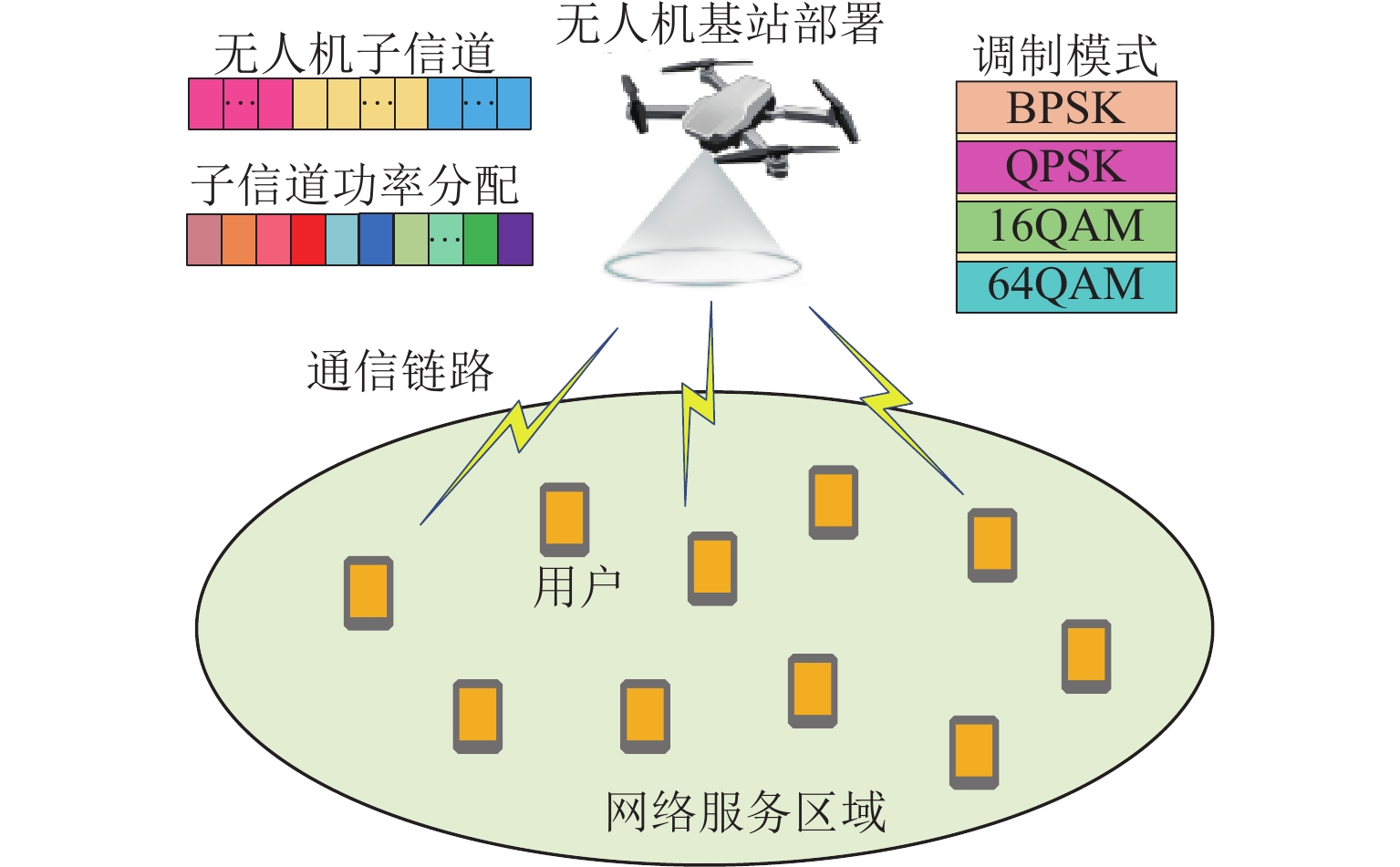
 下载:
下载:
